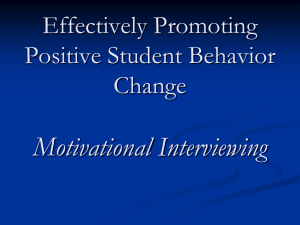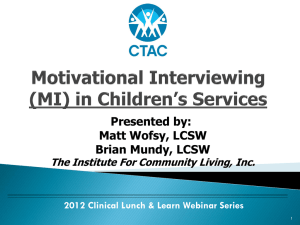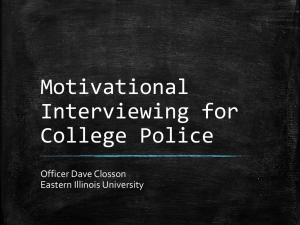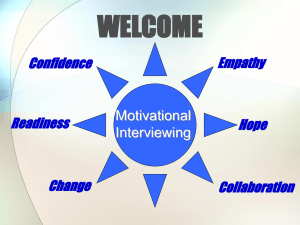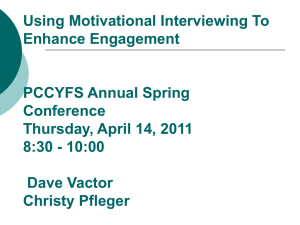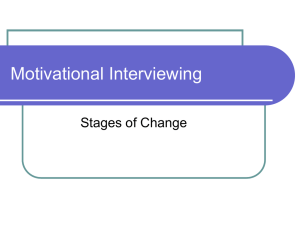Advanced Principles of Motivational Interviewing
advertisement
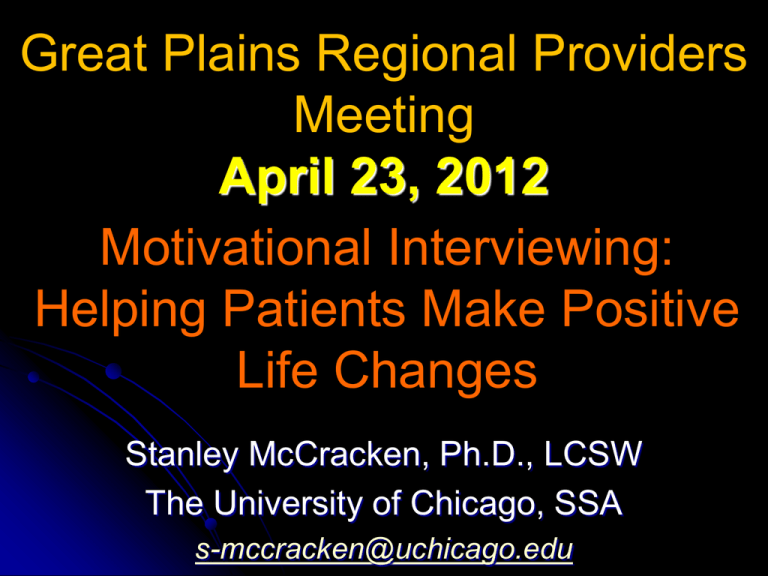
Great Plains Regional Providers Meeting April 23, 2012 Motivational Interviewing: Helping Patients Make Positive Life Changes Stanley McCracken, Ph.D., LCSW The University of Chicago, SSA s-mccracken@uchicago.edu What do you want to learn from this session? “When given a choice between changing and proving that it is not necessary, most people get busy with the proof” John Galbraith Defining Motivation Motivation is the tipping point for making change happen Most of the time it is defined post hoc: if you are successful, you were motivated Alternative terms for motivation: Willpower Commitment Resolution Determination Readiness Motivation & The Change Process Patients are not unmotivated! They are just motivated to engage in behaviors that others consider harmful and problematic or not ready to begin behaviors that we think would be helpful Motivation and the Change Process Motivation belongs to patients and their process of change. However, motivation can be enhanced or hindered by interactions with others and events in the life context of the patients Motivation is best viewed as the patient’s readiness to engage in and complete the various tasks that are outlined in the stages of change How Do People Change? People change voluntarily only when They become interested in or concerned about the need for change They become convinced that the change is in their best interests or will benefit them more than cost them They organize a plan of action that they are committed to implementing They take the actions that are necessary to make the change and sustain the change Motivational Statements “The beatings will continue until morale improves” “If you don’t stop crying, I’ll give you something to cry about” “You will take this medicine, because as your Doctor, I say so” “If you don’t stop, I guarantee something bad will happen!” Motivational Interviewing Motivational interviewing focuses on the “why” of change, rather than the “how” of change. Motivational interviewing has been used with a variety of populations and problems, including substance abuse, medical illness, dentistry, adherence, mental illnesses, comorbid conditions, HIV, sexual offenders. MI is used as a stand alone intervention and in conjunction with other approaches. Readiness Ruler Ready Willing: The importance of change Able: Confidence for change Ready: A matter of priorities Change The Underlying Structure of Change is Neither Technique Oriented Nor Problem Specific. The kind of help people need depends on where they are in the process of change. Stages of Change Contemplation Precontemplation Determination Relapse Maintenance Action Stages of Change Precontemplation: No intention to change behavior in the foreseeable future. Individuals in this stage are unaware or underaware of their problems. Why a person might be in Precontemplation Stage-4 R’s Reluctance. Through lack of knowledge or inertia does not want to change. Impact of problem is not fully conscious. (Provide feedback in empathetic manner.) Rebellion. Heavy investment in problem behavior or making own decisions. Resistant to being told what to do. Hostile. May result from insecurity and fear. (Provide choices.) Why a person might be in Precontemplation Stage-4 R’s Resignation. Lack of energy and investment. Given up on possibility of change and seem overwhelmed by problem. (Instill hope and explore barriers to change.) Rationalization. Has all the answers. Have reasons why problem is not a problem—or is problem for others but not them. Session feels like a debate. (Empathy and reflective listening.) Stages of Change (cont.) Contemplation: A person is aware that a problem exists and are seriously considering changing, but have not yet made a commitment to take action. Contemplators perform a risk-reward analysis. Ambivalence. Stages of Change (cont.) Preparation: Individuals are intending to take action and may practice some of the behaviors necessary. Action: In this stage individuals modify their behavior, experiences, or environment in order to overcome their problems. Maintenance: Individuals in this stage work to prevent relapse and consolidate gains. STAGES OF CHANGE & PRACTITIONER TASKS Raise doubt - Increase the client’s perception of PRECONTEMPLATION risks and problems with current behavior CONTEMPLATION Tip the decisional balance - Evoke reasons for change, risks of not changing; Strengthen client’s self-efficacy for behavior change PREPARATION Help the client to determine the best course of action to take in seeking change; Develop a plan ACTION Help the client implement the plan; Use skills; Problem solve; Support self-efficacy MAINTENANCE Help the client identify and use strategies to prevent relapse; Resolve associated problems RELAPSE Help the client recycle through the stages of contemplation, preparation, and action, without becoming stuck or demoralized because of relapse Predictable Effects of Confrontation Resistance: Non-cooperation Reversal: Eliciting the opposite in ambivalence Reactance: Assertion of autonomy. In motivational interviewing, confrontation is a goal, not a technique. Motivational Interviewing Motivational interviewing is a directive, patientcentered counseling style that enhances motivation for change by helping the patient clarify and resolve ambivalence about behavior change. The Goal of motivational interviewing is to create and amplify the discrepancy between present behavior and broader goals. Create cognitive dissonance between Where one wants Where one is now to be The Spirit of MI MI consists of both a spirit and techniques. While techniques are easier to describe, it is important to understand and exhibit the spirit in order to do MI properly. The MI spirit is characterized by a patient-centered therapeutic relationship based on empathy, unconditional positive regard, collaboration, evocation, respect, autonomy, and acceptance. Motivational Interviewing Assumptions – I Motivation is a state of readiness to change, which may fluctuate from one time or situation to another. This state can be influenced. Motivation for change does not reside solely within the patient. The practitioner’s style is a powerful determinant of client resistance and change. An empathic style is more likely to bring out self-motivational responses and less resistance from the patient Motivational Interviewing Assumptions – II People struggling with behavioral problems often have fluctuating and conflicting motivations for change, also known as ambivalence. Ambivalence is a normal part of considering and making change and is NOT pathological Each person has powerful potential for change. The task of the practitioner is to release that potential and facilitate the natural change process that is already inherent in the individual. Motivating Movement through the Early Stages of Change Critical tasks of the early stages are eliciting concern, dealing with ambivalence regarding change, decision-making, creating commitment, careful and comprehensive planning. Motivational Interviewing approaches are important strategies to engage and work with patients helping them successfully complete these tasks. MI is like dance, not wrestling. Motivational Interviewing Principles Express Empathy Develop Discrepancy Avoid Argumentation Roll with Resistance Support Self-efficacy 1. Express Empathy Acceptance Warmth Openness Personal value Understanding Express Empathy Convey sense that patient’s behaviors make sense given their context and patient’s current way of thinking about them. Reflective listening Reflective listening is key to accurate empathy. Reflective listening is a fundamental skill of motivational interviewing. Use reflective listening when you get ahead of your patient, i.e., when there is resistance. Reflective Listening. Attempt to determine what the individual means and reflect this back to him/her in the form of a statement (not a question). Any statement can have multiple meanings. The worker’s task is to choose the most likely of these meanings and to reflect it back to the individual. Reflective Listening. Reflective listening is a way to check out your understanding of what the individual is telling you, rather than to assume you know what he/she is saying. Summarizing Allows individual to hear him/herself a second time. Allows the interviewer to reflect both sides of the ambivalence. “On the one hand… On the other hand…” Provides a summary of the conversation up to that point. Can be used to transition to a new topic. 2. Develop Discrepancy Awareness of consequences is important Discrepancy between behaviors and goals motivates change Have the patient present reasons for change 3. Avoid Argumentation Avoid pushing or arguing with patients in an attempt to convince them of discrepancies in their thinking 4. Roll with Resistance Use momentum to your advantage Shift perceptions Invite new perspectives, do not impose them Patients are valuable resources in finding solutions to problems 5. Support Self-efficacy Belief that change is possible is important motivator Patient is responsible for choosing and carrying out actions to change There is hope in the range of alternative approaches available Strategies to Develop Discrepancy Ask open-ended questions that pull selfmotivational statements. Reflect back, selectively, the self-motivational aspects of what the patient states Affirm and reinforce the patient for making selfmotivational statements Strategies to Develop Discrepancy cont.... Offer periodic summaries of selfmotivational themes Use medical assessment results Categories of Self-motivational Statements Recognizing the problem Expressing concern Stating intention to change Optimism about change Today Ed overcame his fear of the water. Five Early Strategies: OARS Ask Open-ended questions Affirm: Try to reinforce anything that leads to change and builds the relationship. Listen Reflectively Summarize Elicit self-motivational statements -problem recognition -expression of concern -intention to change -optimism about change Decisional Balance Ambivalence is a normal part of the process of change Use “conflict” to promote positive change Weighing pros and cons of behavior Increasing discrepancy Most useful in Precontemplation and Contemplation stages as a tool to increase motivation Cost-Benefit Analysis Tips Remember, it is the patient’s decision to change; you just want to build ambivalence Decisional Balance Worksheet Good things Not so good things Current Behavior 1. 1. 2. 2. [e.g., Nonadherence] 3. 3. 4. 4. Change 1. 1. [e.g., Adherence] 2. 2. 3. 3. 4. 4. Conducting a Decisional Balance Discussion Accept all answers. (Don’t argue with answers given by patient.) Explore answers. Be sure to note both the benefits and costs of current behavior and change. Explore costs/benefits with respect to patient’s goals and values. Review the costs and benefits. Signs of Readiness to Change Decreased resistance. Decreased questions about the problem. Resolve. Self-motivational statements. Increased questions about change. Envisioning. Providing Information to Promote Adherence Chunk-Check-Chunk vs. Elicit-Provide-Elicit. Chunk-Check-Chunk (a directing style): Provide a chunk of information, check understanding, provide another chunk of information. Continues to actively engage the patient in their own care even when you are informing. Communicates patience and respect. Helps you detect and correct misunderstanding. Providing Information Chunk-Check-Chunk vs. Elicit-Provide-Elicit. Elicit-Provide-Elicit (a guiding style): cyclical style that requires drawing from the patient what they want to know. Start with open question to focus informing: What would you like most to know about_____? OR What do you already know about_____? THEN What more would you like to know? Provide information in a manageable chunk. (Focus initially on information more than on your interpretation of what it means for the patient.) Elicit patient’s response to information you provided: What do you make of that? OR What does this mean for you? OR What more would you like to know? Providing Information EPE involves a more collaborative mindset when goal is health behavior change. The issue is not so much how to get your information across as how to help the patient make sense of it, make good decisions about health behavior, and stick to them. You provide and the patient interprets. Rollnick et al., 2008 Remember Talk less than your patient does On average, reflect (at least) twice for each question you ask When you reflect, use complex reflections more than half the time Remember When you do ask questions, ask mostly open questions Avoid getting ahead of your patient’s readiness (warning, confronting, giving unwelcome advice or direction, taking the “good” side of an argument) One last thing: The Princess and the Frog Sometimes the Magic Works, Sometimes it doesn’t! Resources Miller, W.R. & Rollnick, S. (2002). Motivational Interviewing: Preparing People for Change, 2nd Ed. New York: Guilford. [Third edition due Sep., 2012] Squires, D.D. & Moyers, T.B. (2002). Motivational Interviewing. Online at www.bhrm.org (There are actually two different papers, one is in the substance abuse section and the other is in the MISA section.) Resources Rollnick, S., Miller, W.R., & Butler, C.C. (2008). Motivational Interviewing in Health Care: Helping Patients Change Behavior. New York: Guilford. Arkowitz, H., Westra, H.A., Miller, W.R., & Rollnick, S. (Eds). Motivational Interviewing in the Treatment of Psychological Problems. New York: Guilford. Resources McCracken, S.G. & Corrigan, P.W. (2008). Motivational interviewing for medication adherence in individuals with schizophrenia. In H. Arkowitz, H.A. Westra, W.R. Miller, & S. Rollnick (Eds). Motivational Interviewing in the Treatment of Psychological Problems. 249-276. New York: Guilford. Motivational Interviewing webpage www.motivationalinterview.org

